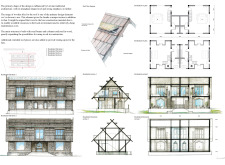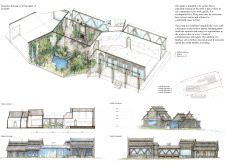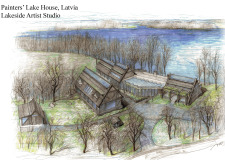5 key facts about this project
At the heart of the architectural design is a series of interconnected spaces that include artist studios, communal living areas, and a gallery. Each part of the complex is designed with careful attention to natural light and views, maximizing interaction with the surrounding landscape. The layout strategically incorporates sightlines towards the adjacent lake, reinforcing the innate connection between the artists and their environment. Movement through these spaces is facilitated by clear pathways, making transitions seamless and enhancing the overall experience of the project.
The primary function of the Painters’ Lake House is to serve as a creative retreat where artists can collaborate and produce their work. The artist studios are designed to be inspiring workplaces, featuring large windows that embrace natural light and indoor gardens that add a sense of tranquility. Generous communal spaces encourage interaction among artists, fostering a vibrant atmosphere conducive to artistic dialogue. Additionally, the dedicated gallery space allows for the exhibition of artworks, transforming the complex into a cultural hub that invites community engagement.
A significant aspect of this architectural project is its commitment to sustainability and local materials. The design prominently features timber, traditionally used in Latvian architecture. This choice not only reflects regional building practices but also enhances the project's ecological footprint by utilizing locally sourced resources. The inclusion of wooden roof tiles and steel beams demonstrates a blend of traditional aesthetics with modern construction techniques, providing structural integrity while maintaining a visually appealing character.
The Painters’ Lake House also boasts unique design elements that set it apart from conventional artist residences. The integration of indoor gardens within the living spaces creates microclimates that support biodiversity, fostering a connection between the inhabitants and local ecology. This attention to ecological sustainability is further underscored by the design’s consideration for local fauna, such as designated spaces for bat habitats. These unique features present a holistic approach to architecture, where the built environment deliberately supports and enhances the surrounding ecosystem.
The architectural design embodies a deep understanding of the cultural context in which it exists, reflecting the heritage of Latvian architecture while embracing modernity. This careful balance allows the Painters’ Lake House to function as both a personal retreat and a community centerpiece, encouraging collaboration among artists from various disciplines. The project not only addresses the practical needs of its users but also reinforces the importance of shared creative spaces.
By fostering an environment that prioritizes creativity, community, and ecological awareness, the Painters’ Lake House stands as a robust example of contemporary architectural design. It serves as a model for future projects aiming to harmonize functionality with sustainability. Those interested in gaining a deeper understanding of the project are encouraged to explore the architectural plans, sections, designs, and ideas that make this project a valuable addition to the landscape of Latvian architecture.


























